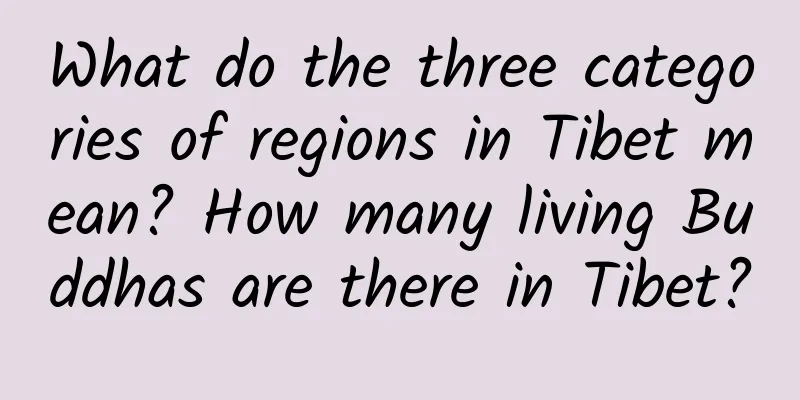What do the three categories of regions in Tibet mean? How many living Buddhas are there in Tibet?

|
Tibet is mysterious, a plateau, a Tibet, a frontier. Eight hundred mountains and rivers, eight hundred prayer flags, eight hundred Sanskrit chants. Three thousand lamas, three thousand khatas, three thousand girls. I have been there, but there is no faith I want there. Where should I go? I always feel that the dream is right beside me, it is out of reach, it is safe and healthy. In just a moment, the world has changed, just because he caught her eyes, he saw her, his messy heart was full of flowers, she looked at him, her gradually withered heart flowers suddenly reappeared in the fall of the gorgeous style. So what does the three types of areas in Tibet mean? How many living Buddhas are there in Tibet? Let's take a look at the introduction of Encyclopedia Knowledge Network below! Contents of this article 1. What do the three types of regions in Tibet mean? 2. How many living Buddhas are there in Tibet? 3. Where are the pilgrimage sites in Tibet? 1What do the three types of regions in Tibet mean?The method of dividing Tibet is based on the altitude of the region, with 4,000 meters as the benchmark and 4,000 to 4,500 meters as the three categories. Tibet is located in the southwest of the Qinghai-Tibet Plateau in China, between 26°50′ and 36°53′ north latitude and 78°25′ and 99°06′ east longitude. It borders Xinjiang Uygur Autonomous Region to the north, Sichuan Province to the east, Qinghai Province to the northeast, Yunnan Province to the southeast, Myanmar, India, Bhutan, Nepal and other countries to the south, and Kashmir to the west. The land border is more than 4,000 kilometers long, with the widest north-south width of more than 900 kilometers and the longest east-west width of more than 2,000 kilometers. It is an important gateway to China's southwestern border and has no access to the sea. 2How many living Buddhas are there in Tibet?There are currently more than 1,700 religious sites, more than 46,000 monks, and more than 400 living Buddhas in Tibet. The Dalai Lama and the Panchen Lama were both created through the reincarnation system. They are both the legal leaders of the Gelugpa sect of Tibetan Buddhism. In religion, he is equal to the Karmapa and the Dharma King Phuntsok. In politics, the Dalai Lama has a greater influence. The Karmapa and the Dharma King Jigme Phuntsok are leaders of two different sects of Tibetan Buddhism. The Dharma King Jigme Phuntsok was designated as the Dharma King by his master because of his achievement in practicing the Great Perfection (the most difficult secret method of Tibetan Buddhism). The Karmapa was created through the reincarnation system. After 1949, the only two great living Buddhas created through the reincarnation system in Tibet are the 17th Karmapa and the 11th Panchen Erdeni. 3Where are the pilgrimage places in Tibet?Located in the center of the old city of Lhasa, it has a history of 1,350 years. It is the most glorious Tubo-era building in Tibet and the earliest civil engineering structure in Tibet. It also pioneered the Tibetan-style temple city bureau. After many renovations and expansions, it has now formed a magnificent scale of more than 25,100 square meters. There are more than 20 halls. The main hall is 4 stories high, with a gilded copper tile roof. It is magnificent and has the architectural style of the Tang Dynasty, and also absorbs the architectural art characteristics of Nepal and India. In the center of the hall is a life-size gilded bronze statue of Sakyamuni at the age of 12 brought by Princess Wencheng from Chang'an. The side halls on both sides are dedicated to statues of Songtsen Gampo, Princess Wencheng, and Princess Bhrikuti of Nepal. Jokhang Temple is not only a temple that houses many Buddha statues and holy objects for believers to worship, but also a three-dimensional and true representation of the Tantric doctrine of the ideal model of the universe in Buddhism - the altar city (mandala). In front of the main entrance of Jokhang Temple, there are three stone pillars. On one of the stone pillars is engraved the Tang-Tibetan alliance signed in 823 AD in both Chinese and Tibetan. |
<<: What equipment should I bring to Tibet in winter? What are the special snacks in Tibet?
Recommend
Is plasma cell mastitis serious?
Plasma cell mastitis is a manifestation of mastit...
What is the reason for irregular menstruation and less menstrual flow?
Due to physiological reasons, women have menstrua...
What are the precautions after medical abortion? Authoritative experts introduce you
After deciding not to have a baby, many people wi...
Is there ovulation during irregular menstruation?
Irregular menstruation is a common gynecological ...
When will the hot-blooded youth be broadcast? Where can I watch the specific update time of the hot-blooded youth?
Speaking of the TV series Hot-Blooded Youth starr...
What to eat to delay menopause
What can you eat to delay menopause? There are ma...
Amazon Appstore app downloads increased 500% year-on-year
December 7, 2012, noon news, Amazon announced on ...
Normal menstruation is painless. Does dysmenorrhea always indicate endometriosis?
Recently, there is a saying that has been widely ...
@All freshmen, how is your sun protection?
Military training is the beginning of the ivory t...
After a few days of menstruation, there is bleeding again
If your period stops for a few days, it may be du...
Are blisters on the mouth caused by "getting angry"?
Not really Blisters around the mouth are not caus...
What are the symptoms and how to treat uterine stromal sarcoma
After a gynecological examination, women often se...
Can I practice yoga during my period?
As modern women play an increasingly important ro...
Neonatal hemolytic disease: the invisible threat of maternal and fetal blood type incompatibility!
Author: Zhong Yan, Chief Physician, Beijing Child...









